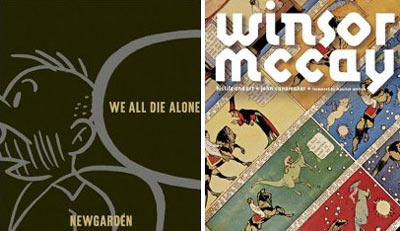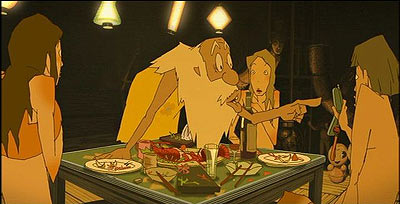

NY Trip Report: 50s Design, New Books and Mind Game
Thanks to Jerry who’s been holding down the Brew fort while I was away in New York City. I was out there working on the design and layout for my upcoming 1950s animation design book. I’m pleased to report that the book is coming together really nicely. It’s been a long, occasionally difficult, journey getting to this point, but everything’s on track and the massive amount of artwork and text is slowly but surely taking form as a mighty solid book. I have to give props to Chronicle; they’ve been immensely supportive and helpful throughout the entire process. Last week, my editor offered up an additional sixteen pages, bringing the book’s total page count to 192. My designer and I will definitely be putting those extra pages to good use.

Also, a couple more New York book plugs. My cartoonist friend Mark “Garbage Pail Kids” Newgarden is wrapping up work on a coffeetable collection of his cartoons and artwork called WE ALL DIE ALONE. I’ve seen handfuls of his work before, and I’m really looking forward to finally seeing an extensive collection of Mark’s funny and skewed cartoon work. The book will be out in October from Fantagraphics. Also, got to visit with the esteemed John Canemaker and had a chance to see the new revised edition of his book on Winsor McCay. No surprise here, but it’s yet another must-have Canemaker book. When I got back to LA, there was a review copy waiting for me in the mail and I can’t wait to dig in. Classic cartoonists rarely get this type of classy coffeetable book presentation, but if anybody deserves it, it’s McCay. Even if you already have the earlier version of John’s Winsor McCay book, there’s more than enough new material in this revised edition to justify the purchase.
As a sidenote, Mark Newgarden also treated me to a cartoon screening of some of the weirdest classic cartoons I’ve seen in a while. If Jerry Beck is the master of the “worst cartoons show” then Mark is king of the “oddball cartoons show.” Among the highlights:
* An early-1960s John Sutherland industrial, FAMILIES OF STEEL, which is the only time illustrator Boris Artzybasheff designed characters for an animated film. Other notable elements in this short: groovy Sixties color styling by Bob Dranko and goofy dancing steel animation by Art Babbitt.
* The cheapest, most poorly animated UPA film I’ve ever seen, a no-budget project for the American Cancer Society called SAPPY HOMIENS (1956). Half of the film is a live-action sequence starring UPA storyman Leo Salkin thinking about how he’s going to make the cartoon. “So bad it’s good” certainly applies in this case.
* One of the most grotesquely designed stop motion films ever, a gem from the 1920s called IN THE SPRING. It’s stop motion bizarreness on a “Charlie Bowers” level and even includes a dog milking a cow. If anybody out there knows who did this film, please let us know.
The other animation highlight of my New York trip was finally getting the chance to see the much-lauded animated feature MIND GAME (2004), directed by Masaaki Yuasa. The film was screening as part of the Museum of Modern Art’s anime film series, and as far as I know, it’s the first time the film has received theatrical play in the United States (Tamu Townsend writes that the film’s first US theatrical screening was actually this past June at the NY Asian Film Festival). If ever there was an appropriate rebuttal to the modern American animator’s insistence of imposing live-action scripts and filmmaking techniques onto the cartoon art form, MIND GAME is it. This film is fully and truly animated, from conception through execution, every one of its frames stretching the medium to the limits of its expressive potential. Comparisons between MIND GAME and other animated films are simply inadequate. Granted, at moments it recalls FANTASIA, YELLOW SUBMARINE and Bob Clampett’s Warner Bros. shorts, but its sum total is more than any of these; MIND GAME stands alone as one of the most fearlessly original and creative pieces of animation ever produced.

The film’s brilliance doesn’t stem simply from the variety of visual styles and techniques that it employs, but rather from how director Yuasa incorporates style and technique into a thematically-complex, emotionally-involving narrative. To borrow a thought from animation critic Ben Ettinger (the individual who first turned me onto this film), “Few films I’ve ever seen combined artistic experimentation and comprehensibility in as thought-provoking and mind-bogglingly imaginative a package as this one…Never have I seen animation that was simultaneously so constantly interesting and exciting and that served a greater purpose than mere surface-level titillation. It all works together perfectly, and every moment has surprises.”
My mind is so swamped with other things at the moment that I can’t devote the time to writing a proper review of this film, but rest assured I’ll be writing plenty more about MIND GAME in the months to come. This film heralds the arrival of a new age of the animated film where art, technology and story will be integrated in previously unimaginable ways. Here are links to more MIND GAME praise (and believe me, not a single word of it is hype):
Phil Hall on FILM THREAT
Joshua Smith on Cartoon Brew
Mark Mann at Twitch
A.O. Scott in the NY TIMES (free reg. req’d)
and a huge archive of MIND GAME coverage at Ben Ettinger’s AniPages Daily
